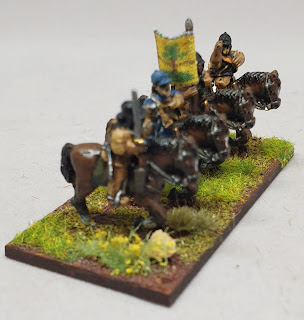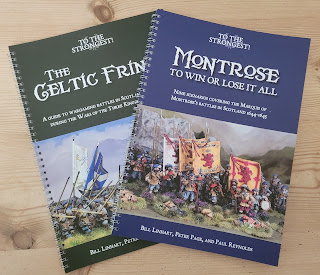Sir William Waller’s Regiment of Horse
The spotlight falls upon Sir William Waller's Regiment of Horse.
Raised in 1642, it'll come as no surprise that they were stalwarts of the Southern Association, and wherever Sir William went... his Regiments were sure to follow.
They took Portsmouth early in 1642 for Parliament; fought at Edgehill, present at Turnham Green, stormed Farnham Castle and Winchester, took Arundel Castle, besieged Chichester, and that's just what they got upto in 1642.
Stormed Malmesbury; fought at Highnam; helped take Monmouth, Chepstow and Ross on Wye; fought at Ripple Dean (a very overlooked battle it must be said); siege of Hereford; siege of Worcester; skirmishing at Chewton Mendip, Beckington, Leigh and Monckton Farleigh; battle of Lansdown; siege of Devizes; more skirmishing at Beckhampton and possibly Andover too; Roundway Down; Basing House; Alton Church; siege of Arundel; Cheriton; Newbury skirmishing; Cropredy Bridge; lots more skirmishing; back to Basing House; Second Newbury then home for tea and medals.
Sir William was an absolutely fascinating fellow*, facing his bestie (Sir Ralph Hopton) across the battlefield. Surely there's a good Hollywood blockbuster waiting to be written about the friendship that continued between these two men despite being on opposite sides of the battlefield.
If Lottery tickets had been on sale in seventeenth century England, Waller should have bought one; an incredibly lucky man who had numerous horses shot from under him, close shaves with enemy soldiers (and his own!); falling off his horse at Cheriton without wearing the correct PPE; having walls fall on him and a building collapse around him; and that's not mentioning dodging the Inquisition and the plague.
Took part in the Bohemian expedition, 1620, to rescue Princess Elizabeth (Charles I's sister). Returned home, got knighted, inherited a vast fortune, got married, sadly lost his wife in childbirth (impressive memorial to Jane at Bath Cathedral), got married again, acquired a castle, and if that wasn't enough became an MP.
At the outbreak of war he sided with Parliament and raised his Regiment of Horse. At Edgehill the Regiment was scattered by Rupert's Horse, and William realised the importance of training his soldiers, as opposed to the traditional approach of giving a man a sharp object and telling him he was a soldier. By the end of 1642 he became known a William the Conqueror due to his string of victories which secured the western approach to London.
In 1643 he faced his good friend Sir Ralph Hopton at Lansdowne and Roundway Down. Hopton was temporarily blinded after Lansdowne, despite him being 'the enemy' Waller offered him hospitality in Bath to recover. Hopton politely declined the invitation. Roundway was the heaviest defeat that William the Conqueror would sustain.
Promoted to Major General he took command of the Southern Association, sadly a bit of friction with the Earl of Essex (namely deciding who was to command the two combined armies) meant some hasty decisions were made and the shine of 'William the Conqueror' was slightly dimmed. With the formation of the New Model Army and the publication of the Self Denying Ordinance, Sir William's military career was over.
He returned to Parliament as an MP; only to be ejected from Parliament by the army in 1647, having to live in exile on the continent. Returned to England in 1648, he'd find himself arrested as an Engager sympathiser and imprisoned for four years. He would later be imprisoned in the Tower of London on suspicion of complicity in Booth's Rebellion.
He would be a prominent figure in the calls for the Restoration, returning to Parliament as the MP for Westminster. Upon Charles II's return he retired from Parliament. He died in 1668, and is buried in New Chapel, St Margaret's Church, Westminster.
*I must point out that the use of 'fellow' is purely used for alliterative purposes, and in no way is indicative of the use language at Chateau KeepYourPowderDry.
Raised in 1642, it'll come as no surprise that they were stalwarts of the Southern Association, and wherever Sir William went... his Regiments were sure to follow.
They took Portsmouth early in 1642 for Parliament; fought at Edgehill, present at Turnham Green, stormed Farnham Castle and Winchester, took Arundel Castle, besieged Chichester, and that's just what they got upto in 1642.
Sir William was an absolutely fascinating fellow*, facing his bestie (Sir Ralph Hopton) across the battlefield. Surely there's a good Hollywood blockbuster waiting to be written about the friendship that continued between these two men despite being on opposite sides of the battlefield.
Painted by Alan Tuckey, basing by myself
Took part in the Bohemian expedition, 1620, to rescue Princess Elizabeth (Charles I's sister). Returned home, got knighted, inherited a vast fortune, got married, sadly lost his wife in childbirth (impressive memorial to Jane at Bath Cathedral), got married again, acquired a castle, and if that wasn't enough became an MP.
At the outbreak of war he sided with Parliament and raised his Regiment of Horse. At Edgehill the Regiment was scattered by Rupert's Horse, and William realised the importance of training his soldiers, as opposed to the traditional approach of giving a man a sharp object and telling him he was a soldier. By the end of 1642 he became known a William the Conqueror due to his string of victories which secured the western approach to London.
In 1643 he faced his good friend Sir Ralph Hopton at Lansdowne and Roundway Down. Hopton was temporarily blinded after Lansdowne, despite him being 'the enemy' Waller offered him hospitality in Bath to recover. Hopton politely declined the invitation. Roundway was the heaviest defeat that William the Conqueror would sustain.
Promoted to Major General he took command of the Southern Association, sadly a bit of friction with the Earl of Essex (namely deciding who was to command the two combined armies) meant some hasty decisions were made and the shine of 'William the Conqueror' was slightly dimmed. With the formation of the New Model Army and the publication of the Self Denying Ordinance, Sir William's military career was over.
He returned to Parliament as an MP; only to be ejected from Parliament by the army in 1647, having to live in exile on the continent. Returned to England in 1648, he'd find himself arrested as an Engager sympathiser and imprisoned for four years. He would later be imprisoned in the Tower of London on suspicion of complicity in Booth's Rebellion.
He would be a prominent figure in the calls for the Restoration, returning to Parliament as the MP for Westminster. Upon Charles II's return he retired from Parliament. He died in 1668, and is buried in New Chapel, St Margaret's Church, Westminster.
*I must point out that the use of 'fellow' is purely used for alliterative purposes, and in no way is indicative of the use language at Chateau KeepYourPowderDry.
If you enjoyed reading this, or any of the other posts, please consider supporting the blog.
Thanks.













I love these regimental histories. Waller’s horse were busy boys (alliteration again!) and in my youth that would have had me laying claim to ‘veteran’ status if I had a Parliamentarian army.
ReplyDeleteMe too...
DeleteI always thought it hugely sad that two mates like that fought on separate sides...
Thanks all,
Deletethe civility that they managed to show one another during the uncivil time is remarkable.
Incredible man really; his regiment of horse weren't too shabby either!
ReplyDeleteAgreed. The more I read and learn about him, the more and more impressed I become.
Delete